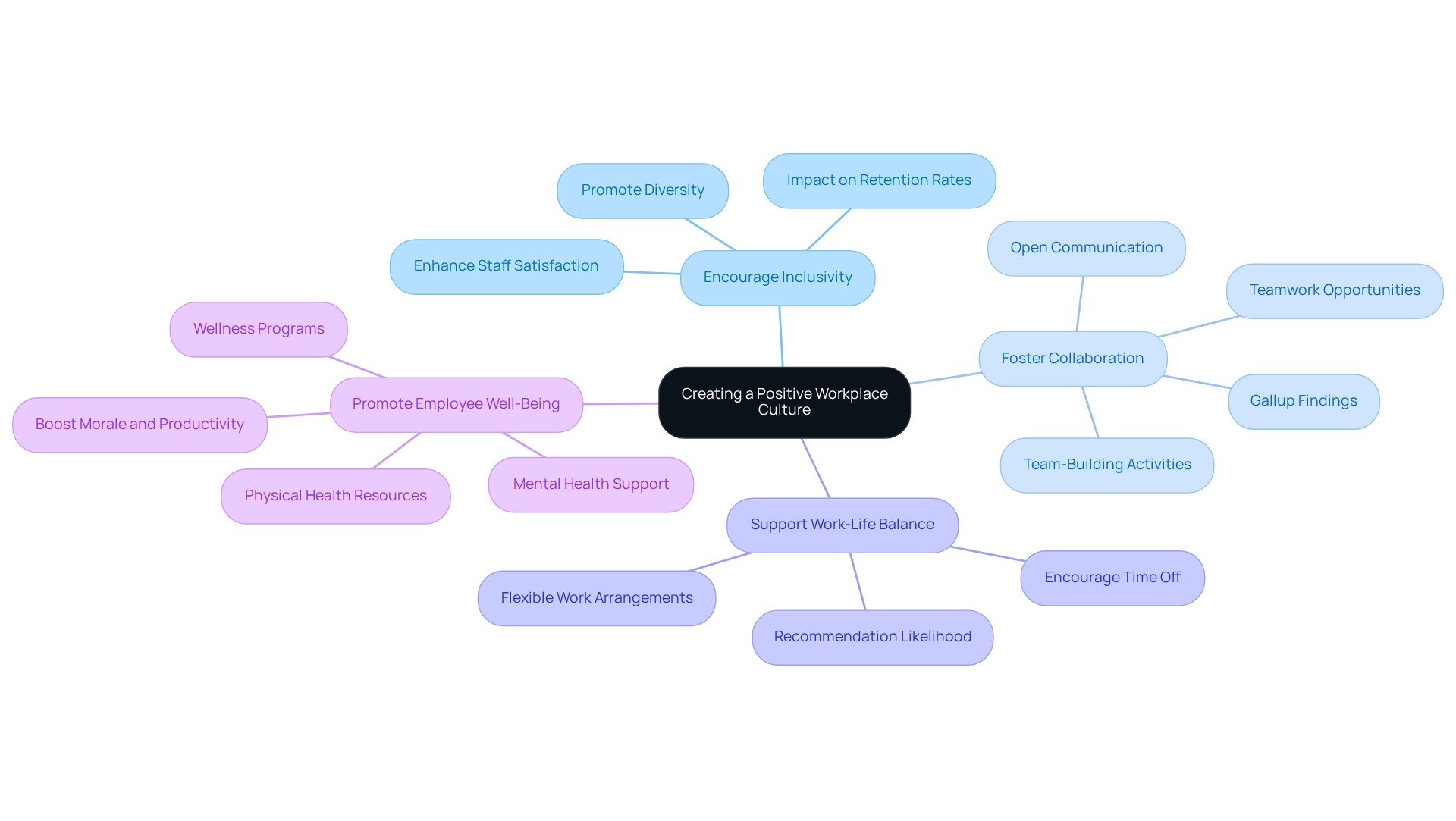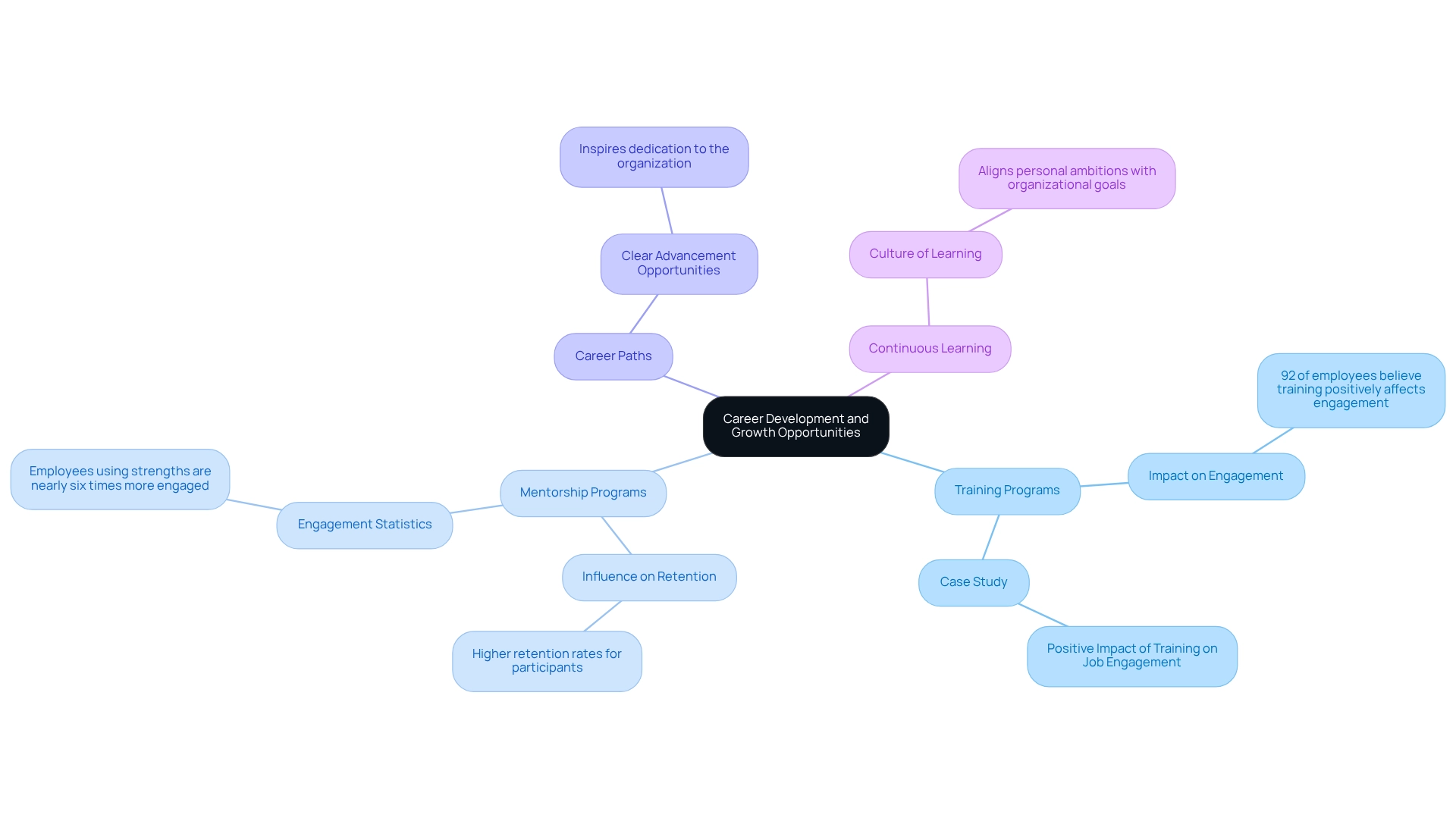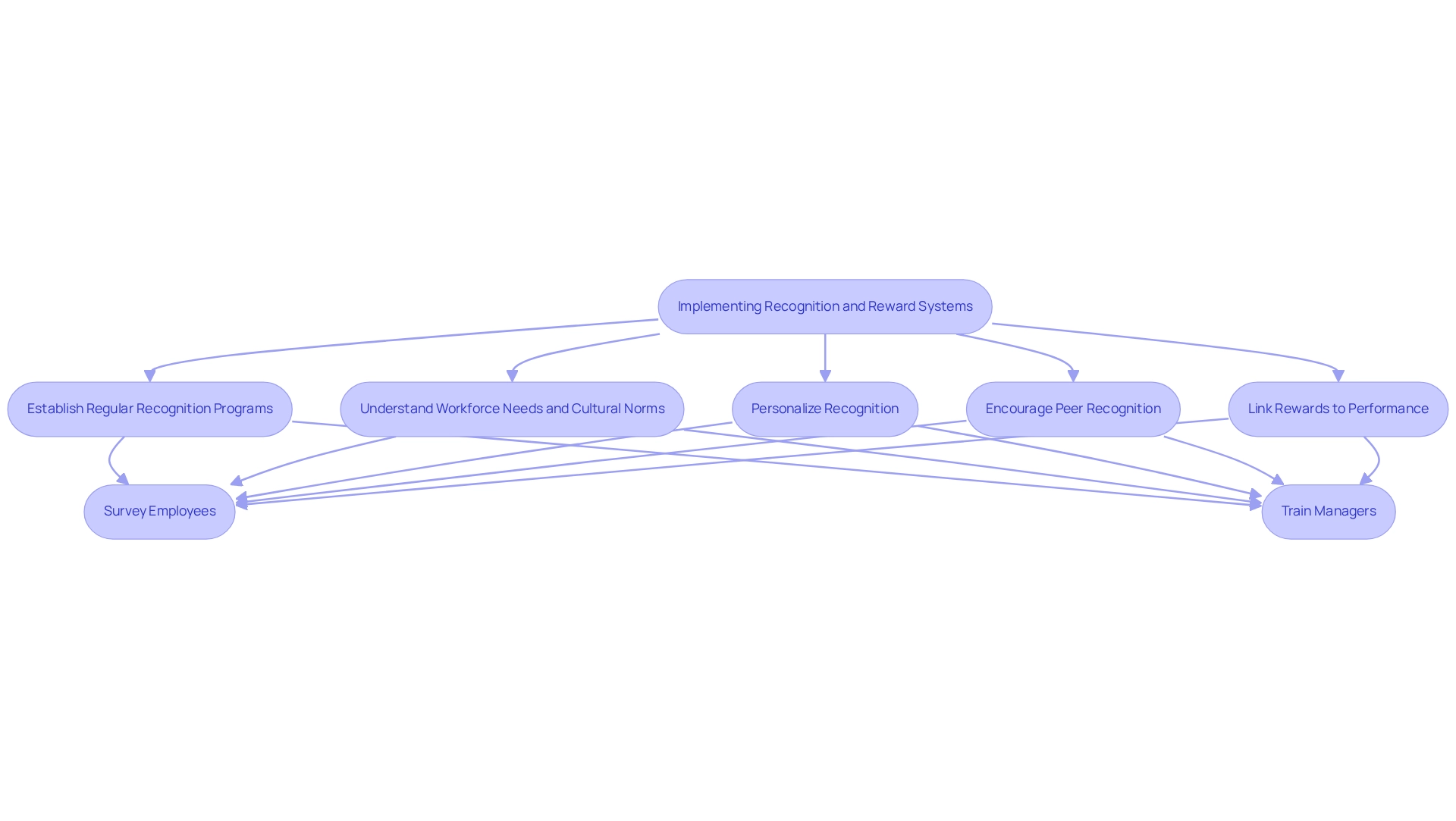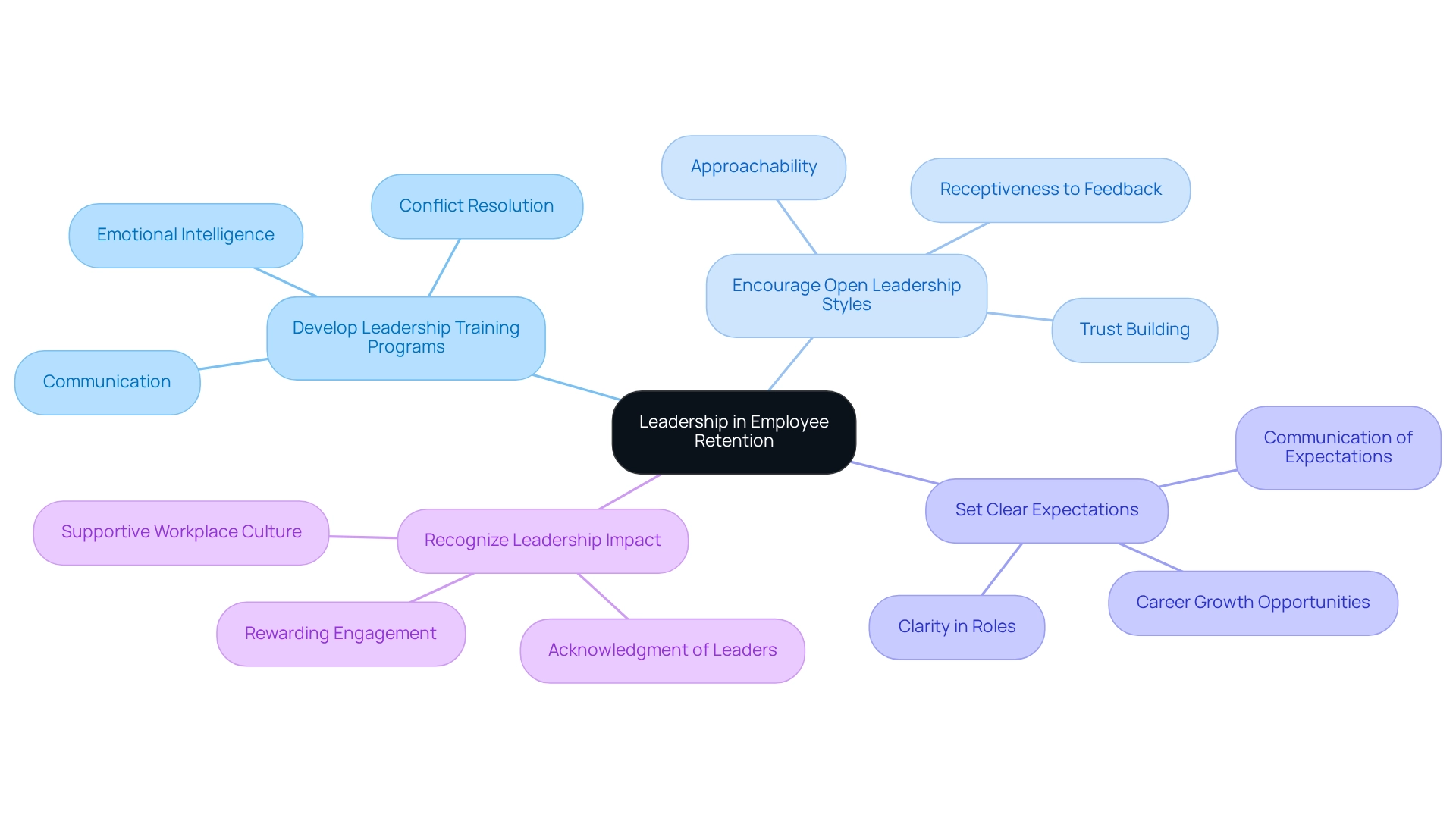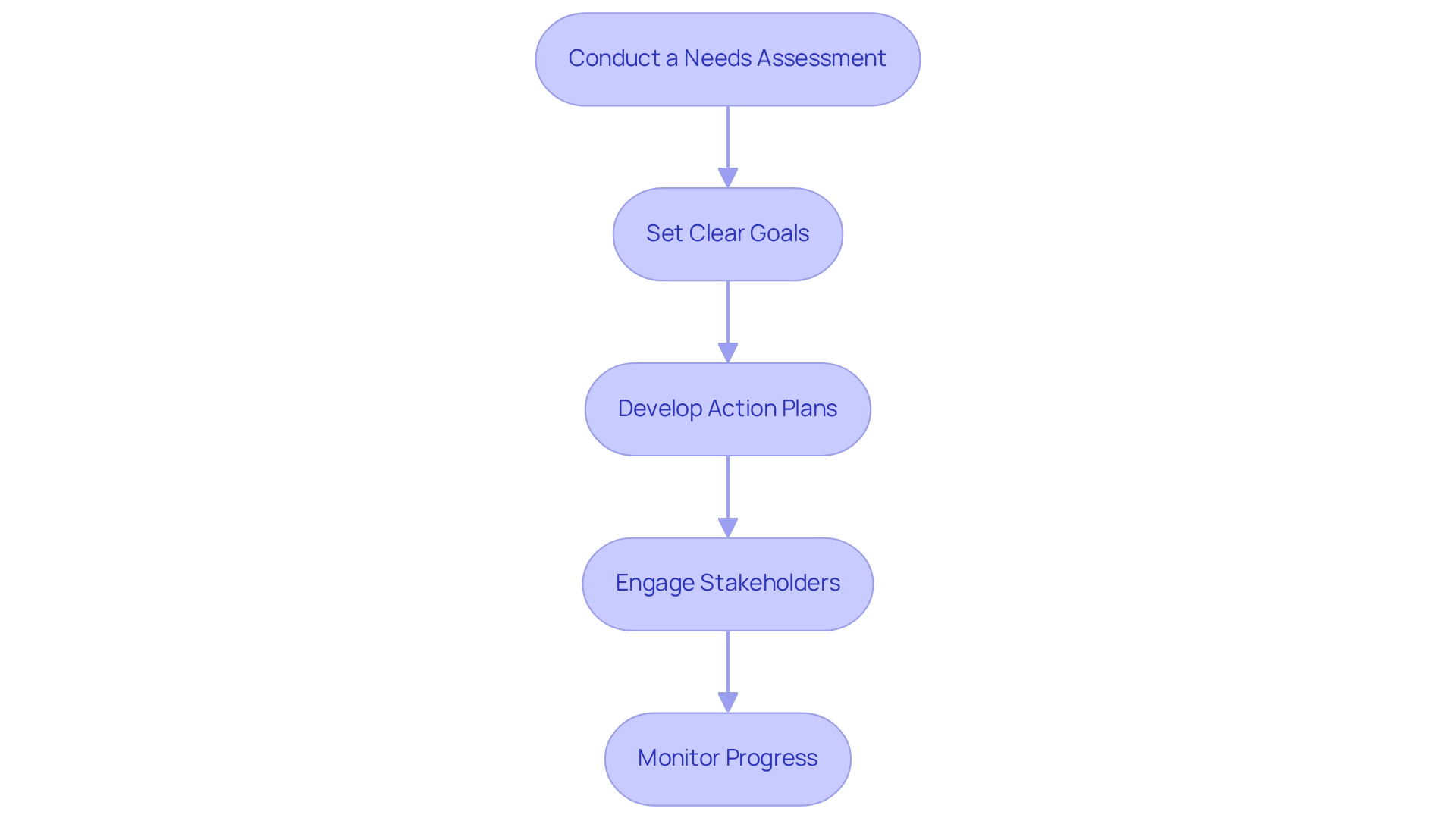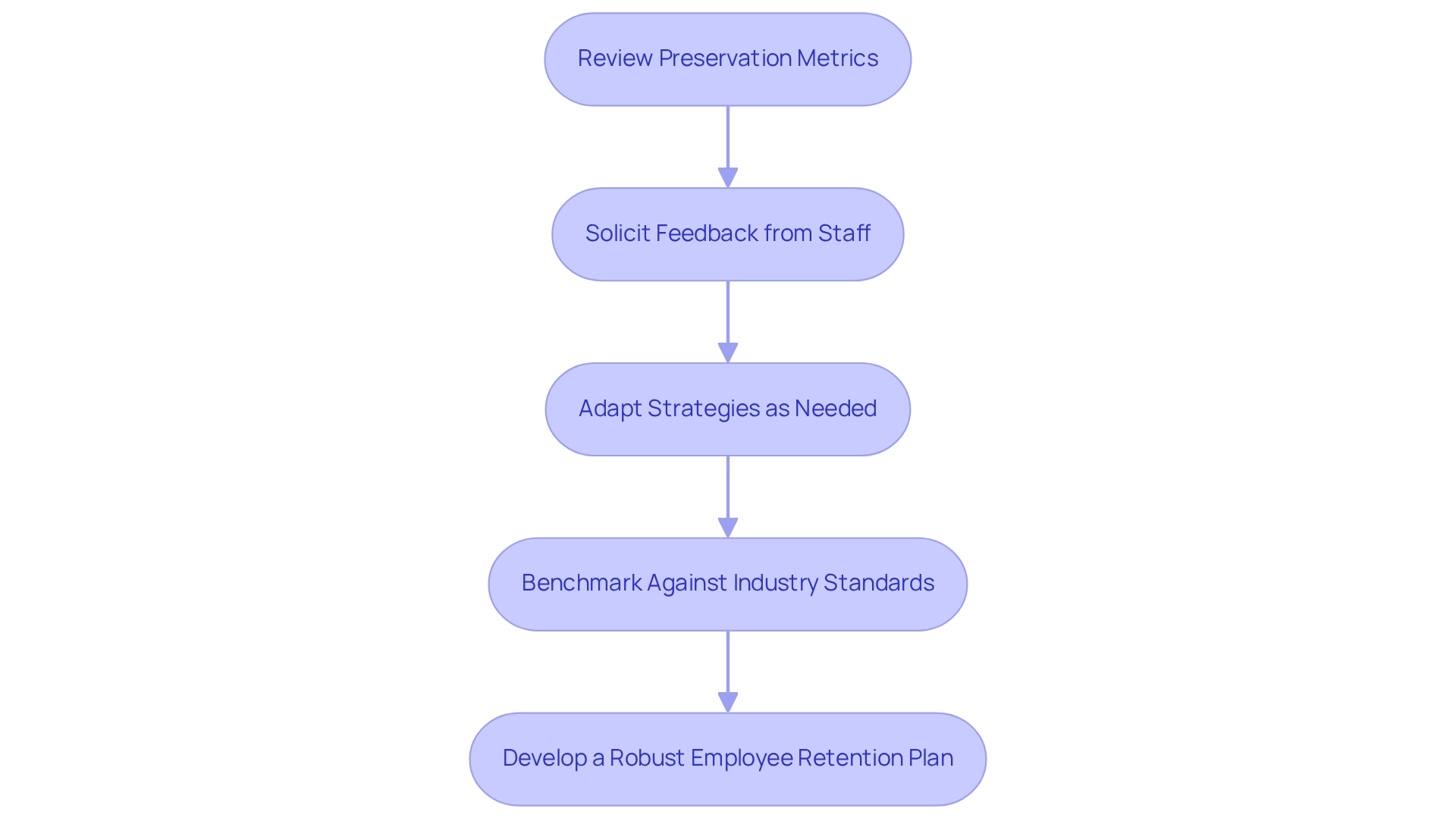Overview
To create an effective employee retention plan, HR managers must prioritize strategies that yield tangible results.
- Providing career advancement opportunities
- Fostering a positive workplace culture
- Implementing recognition programs
These are essential components of this approach. Notably, high employee loyalty correlates with lower turnover costs, a fact that underscores the necessity of these strategies. Organizations that prioritize employee development and maintain open communication not only enhance engagement but also see significantly higher retention rates.
How can your organization implement these strategies to improve retention? The answer lies in a commitment to cultivating a supportive environment that values employee contributions.
Key Highlights:
- Employee loyalty is critical for reducing hiring costs, improving morale, and enhancing productivity.
- High staff loyalty rates correlate with 25% lower turnover costs and engaged employees are 87% less likely to leave.
- Effective retention strategies include career advancement opportunities, targeted initiatives, staff recognition programs, and competitive compensation.
- Companies that prioritize employee development see higher loyalty rates; 92% of staff believe training positively impacts engagement.
- A positive workplace culture, characterized by inclusivity and collaboration, significantly enhances retention rates.
- Regular feedback and open communication are essential to address employee concerns and foster engagement.
- Leadership plays a key role in retention; effective leaders support their teams and communicate expectations clearly.
- Implementing structured steps like needs assessments and stakeholder engagement is crucial for effective retention plans.
- Continuous evaluation and adaptation of retention strategies based on employee feedback and industry benchmarks are necessary for success.
Introduction
In today’s competitive job market, the ability to retain employees has become a critical focus for organizations aiming for long-term success. High employee turnover incurs significant costs and disrupts productivity, undermining workplace morale. As businesses navigate the complexities of retention, understanding the underlying factors that contribute to employee satisfaction is essential.
This article delves into the importance of employee retention, exploring effective strategies that organizations can implement to foster a committed workforce.
From enhancing career development opportunities to cultivating a positive workplace culture, the discussion highlights actionable steps that HR managers can take to create an environment where employees feel valued and engaged.
Understanding Employee Retention: Why It Matters
Employee loyalty stands as a crucial metric for companies, reflecting their ability to maintain a consistent workforce over time. In 2025, the significance of high loyalty rates cannot be overstated; they directly correlate with reduced hiring expenses, improved staff morale, and enhanced productivity. When employees feel valued and engaged, they are significantly less likely to leave their positions. This retention is vital for preserving institutional knowledge and fostering a positive workplace culture.
Investing in an employee retention strategy not only benefits the workforce but also drives the overall success of the organization. For instance, companies boasting high staff loyalty rates frequently experience turnover costs that are 25% lower, underscoring the financial advantages of nurturing a dedicated team. Furthermore, engaged employees are 87% less likely to depart from their companies compared to their disengaged counterparts, highlighting the essential role of workforce engagement in talent retention.
To illustrate effective strategies for employee retention, many organizations are now focusing on:
- Career advancement opportunities
- Targeted initiatives
- Staff recognition programs
- Competitive compensation packages
Boutique Recruiting exemplifies this strategy by customizing its recruitment services to meet the specific needs of clients, ensuring that candidates not only possess the requisite skills but also align with the company culture. As Eric Eddy noted, the firm’s ability to deliver high-quality candidates swiftly and effectively is a hallmark of successful recruitment, relevant to retention strategies as well.
Current statistics reveal that individuals who perceive they are advancing in their careers are 20% more likely to remain with their organizations for at least a year. This data underscores the necessity of cultivating an environment where career growth is prioritized. Additionally, organizations that implement robust recognition programs often witness a significant increase in loyalty rates, as employees who feel appreciated for their contributions are more inclined to remain committed.
In summary, the impact of employee loyalty on corporate success is profound. By prioritizing strategies that emphasize workforce engagement, recognition, and career development, HR managers can establish an effective employee retention plan, fostering a more stable and productive team that ultimately propels the organization toward greater success.
Key Components of an Effective Employee Retention Plan
An effective employee retention plan should encompass several key components that not only attract talent but also foster long-term commitment among employees:
- Competitive Compensation and Benefits: Offering salaries and benefits that are competitive within the industry is essential for attracting and retaining top talent. Studies show that 51% of workers who resign from their positions have not talked about their job satisfaction or career prospects for months before their exit. This emphasizes the necessity for proactive compensation strategies and open communication to address staff concerns before they result in turnover.
- Career Development Opportunities: Providing staff access to training, mentorship, and clear career advancement paths is crucial. Organizations that invest in their staff’s professional development often observe higher loyalty rates, as individuals feel appreciated and envision a future within the company.
- Positive Workplace Culture: Cultivating an inclusive and supportive environment is vital. A positive workplace culture not only enhances staff satisfaction but also encourages loyalty. Businesses in fields with historically high employee turnover, such as hospitality and construction, can gain insights from sectors with improved employee longevity, like finance and insurance. This knowledge can assist financial firms in creating targeted strategies that enhance staff engagement.
- Recognition and Rewards: Establishing systems to consistently recognize and reward staff accomplishments can significantly enhance morale and loyalty. Acknowledging contributions nurtures a sense of belonging and inspires team members to excel. As Eric Eddy observed, the firm’s capacity to provide exceptional candidates swiftly and effectively highlights the significance of acknowledging contributions as part of a comprehensive retention strategy.
- Open Communication: Establishing effective channels for feedback and dialogue between staff and management is essential. Open communication allows for the timely addressing of concerns and suggestions, creating a more engaged workforce.
- Seamless Recruitment Processes: In today’s competitive job market, often referred to as the “war for talent,” the very best candidates are not just looking for any job; they are seeking the right fit with the right company. This means that hiring managers must ensure a seamless interview process to avoid losing out on top talent. Candidates are assessing companies just as much as they are being assessed, making it essential for firms to portray themselves favorably during recruitment. Furthermore, candidates are vigilant for red flags during the interview process, which underscores the need for a polished and professional hiring experience.
By incorporating these elements into an employee retention plan, organizations can reduce turnover, which data indicates is avoidable in 42% of cases. This proactive approach not only enhances staff satisfaction but also strengthens the overall organizational culture, making it a strategic imperative for HR managers in the financial sector. Moreover, Boutique Recruiting’s history of achievement and many pleased clients and candidates strengthen the link between effective recruitment and workforce stability outcomes, especially for high-demand roles like CFO, Financial Manager, and other essential positions in finance and technology.
Identifying Causes of Employee Turnover
To effectively reduce turnover, HR managers must conduct thorough analyses to identify the primary causes of staff departures. Understanding these factors is crucial for developing a targeted employee retention plan. Common reasons for employee turnover include:
- Lack of Career Advancement: Employees often leave when they perceive limited opportunities for growth within their organization. A clear path for career progression is essential for retaining talent, as individuals are more likely to stay when they see potential for advancement.
- Inadequate Compensation: When workers feel they are not rewarded fairly for their contributions, they may seek higher-paying opportunities elsewhere. Competitive salary packages and benefits are vital in retaining skilled professionals, particularly in the financial sector where compensation can significantly influence job satisfaction.
- Poor Management Practices: Employees are likely to leave if they feel unsupported or undervalued by their supervisors. Effective management practices, including regular feedback and recognition, play a critical role in staff retention. Organizations that actively pursue staff feedback have been demonstrated to experience a 14.9% decrease in turnover rates, emphasizing the significance of communication in enhancing worker-manager relationships. The case study titled “Effect of Regular Feedback on Turnover” illustrates how implementing consistent feedback mechanisms can effectively reduce turnover and improve these relationships.
- Work-Life Imbalance: A lack of flexibility can lead to burnout and dissatisfaction, prompting workers to seek more accommodating environments. Fifty-four percent of staff who felt unappreciated reported unmanageable work stress, compared to just 13% of those who felt valued. This highlights the significance of staff appreciation in the employee retention plan. Organizations that prioritize work-life balance and provide flexible working arrangements often implement an effective employee retention plan to retain staff.
Action Steps:
- Conduct exit interviews to gather insights from departing employees, which can reveal specific reasons for turnover and areas for improvement.
- Analyze turnover data to identify trends and common factors, enabling HR managers to address underlying issues proactively.
- Implement regular feedback mechanisms to enhance communication and foster a supportive workplace culture. As Eric Eddy noted, the firm’s ability to deliver top-notch candidates quickly and efficiently is a testament to the importance of effective management practices in retaining talent.
Creating a Positive Workplace Culture
A positive workplace culture is crucial for the success of an employee retention plan, particularly in the competitive environment of financial services. To cultivate such an environment, HR managers should focus on several key strategies:
- Encourage Inclusivity: Actively promote diversity within the organization, ensuring that all employees feel valued and included. Organizations that prioritize inclusivity not only enhance staff satisfaction but also observe a significant impact on retention rates. For example, organizations that promote an inclusive environment report greater staff engagement, which is directly connected to reduced turnover. As TH Herbert, CEO of Semarchy, states, “This will reassure your team that their voices matter and drive loyalty.”
- Foster Collaboration: Create opportunities for teamwork and open communication among team members. Promoting teamwork can result in a more unified work atmosphere, where staff feel connected and engaged in their roles. Regular team-building activities can strengthen relationships and enhance overall morale. Gallup’s findings demonstrate a direct relationship between high staff engagement and reduced turnover, highlighting the significance of promoting collaboration.
- Support Work-Life Balance: Implement flexible work arrangements and encourage staff to take time off when needed. Studies show that individuals who are pleased with their work-life balance are 2.1 times more inclined to suggest their organization to others, highlighting the importance of this factor in an employee retention plan.
- Promote Employee Well-Being: Offer wellness programs and resources that support both mental and physical health. A focus on staff well-being not only boosts morale but also contributes to increased productivity and innovation within the organization.
By emphasizing these approaches, HR managers can create an employee retention plan that fosters a positive workplace culture, attracting talent while also keeping it, ultimately resulting in a more engaged and productive workforce. A robust company culture is crucial for attracting and retaining talent, with businesses that prioritize worker well-being experiencing enhanced productivity and innovation.
Providing Career Development and Growth Opportunities
To retain top talent, organizations must prioritize career development as a cornerstone of their retention strategy. HR managers can implement several key initiatives that significantly impact employee engagement and loyalty.
- Offer Training Programs: Providing access to workshops, online courses, and certifications greatly enhances employees’ skills. A survey indicates that 92% of staff believe workplace training positively affects their job engagement. This statistic is supported by a case study titled ‘Positive Impact of Training on Job Engagement,’ which underscores the necessity of effective training programs in enhancing satisfaction and loyalty.
- Implement Mentorship Programs: Pairing individuals with mentors can profoundly influence their professional growth. Mentorship not only encourages skill enhancement but also strengthens the employee retention plan. Individuals who participate in mentorship programs frequently report higher retention rates. Furthermore, statistics reveal that those who understand and leverage their strengths are nearly six times more engaged, highlighting the importance of customized development opportunities within mentorship structures.
- Create Clear Career Paths: Outlining potential advancement opportunities within the organization inspires staff to envision their future with the company. When employees comprehend their development path, they are more likely to remain dedicated to their positions.
- Encourage Continuous Learning: Fostering a culture of learning is essential. Assisting staff in seeking additional education and training not only improves their skills but also aligns their personal ambitions with organizational goals.
Incorporating these practices can yield significant benefits. Regular discussions about career goals during performance reviews ensure alignment and address any concerns. Allocating budgets specifically for employee development initiatives demonstrates a commitment to growth; high-impact leadership groups invest up to three times more in management development compared to their peers, illustrating the value placed on training and development.
Leveraging insights from HR professionals to refine mentorship programs ensures they effectively meet the needs of both mentors and mentees.
As Warren, a renowned authority in human capital management, aptly remarked, “The bottom line is that any entity that doesn’t offer development incentives to its people is not optimizing its human capital.” By investing in career development and mentorship, organizations can foster a more engaged and loyal workforce, ultimately resulting in enhanced employee loyalty.
Implementing Recognition and Reward Systems
Recognition and reward systems play a pivotal role in motivating employees and are essential components of an effective employee retention plan. To effectively implement these systems, HR managers should consider the following strategies:
- Establish Regular Recognition Programs: Implementing monthly or quarterly awards can significantly boost morale by acknowledging outstanding performance. Such programs not only highlight individual achievements but also foster a culture of appreciation within the organization.
- Understand Workforce Needs and Cultural Norms: Before launching recognition programs, it is essential for business leaders to comprehend the unique needs and cultural norms of their staff. This understanding allows for more tailored and effective recognition efforts.
- Personalize Recognition: Tailoring recognition efforts to individual preferences is essential. This could involve public acknowledgment during team meetings, financial bonuses, or personalized notes of appreciation. Recognizing that workers have varied motivations can result in more significant acknowledgment, which is essential since individuals who feel appreciated are less prone to experience high levels of stress and more inclined to stay engaged.
- Encourage Peer Recognition: Creating platforms for individuals to acknowledge one another’s contributions can enhance team cohesion and morale. Peer acknowledgment not only empowers staff but also cultivates a supportive work atmosphere where everyone feels valued.
- Link Rewards to Performance: It is vital to ensure that rewards are tied to measurable performance metrics. This approach strengthens preferred behaviors and encourages individuals to pursue excellence. A study by the Society for Human Resource Management indicates that recognition is the third most important factor in worker satisfaction, following job security and compensation.
Implementation Steps:
- Survey Employees: Conduct surveys to gather insights on preferred recognition methods, ensuring that the programs resonate with the workforce.
- Train Managers: Provide training for managers on effective recognition practices, equipping them with the skills to implement these strategies successfully.
By prioritizing staff involvement and acknowledgment, organizations can cultivate higher morale, decrease turnover, and improve overall engagement as part of their employee retention plan. Organizations that invest in grasping their staff’s needs and preferences for acknowledgment are likely to see a significant return on investment, making the employee retention plan a critical focus for growth. Notably, only 33% of U.S. workers feel engaged at work, highlighting the necessity for effective recognition programs.
Moreover, workers who do not feel appreciated are twice as likely to experience high levels of stress, highlighting the negative effect of insufficient recognition on staff well-being and job stability. The case study titled “The Need for Engagement Strategies” concludes that prioritizing workforce involvement and recognition is essential for organizational success, emphasizing the potential ROI of such investments.
Fostering Open Communication and Feedback
Effective communication stands as a cornerstone of workforce engagement, an essential element for a successful employee retention plan. HR managers at Boutique Recruiting can significantly enhance their strategies by focusing on the following key practices:
- Implement Regular Check-Ins: Schedule consistent one-on-one meetings to address staff concerns and gather feedback. This personal touch not only aids in understanding individual needs but also fosters a sense of belonging.
- Create Feedback Channels: Establish anonymous feedback systems that encourage honest communication. Such channels enable staff to express their opinions without fear of consequences, resulting in more candid insights.
- Promote Transparency: Share organizational updates and decisions openly to build trust within the team. Clarity in communication has been shown to greatly improve worker satisfaction. Research indicates that individuals who experience transparent communication report 12 times higher job satisfaction than those who do not. This principle reflects the openness candidates should adopt during the recruitment process, where being honest about workstyle preferences, salary expectations, and individual personal circumstances can build trust with hiring managers.
- Promote Two-Way Communication: Foster an atmosphere where staff feel at ease sharing their ideas and concerns. This approach not only elevates morale but also fuels innovation, as 40% of staff members believe that regular communication enhances team creativity. Just as candidates should share personal insights during interviews to connect with hiring managers, organizations should encourage staff to express their thoughts to strengthen workplace relationships.
Best Practices:
- Utilize staff surveys to assess the effectiveness of communication methods and identify areas for improvement.
- Provide training for managers on active listening and constructive feedback techniques to ensure that communication is both effective and supportive.
By implementing these practices, organizations can cultivate a culture of open communication that not only enhances staff engagement but also significantly contributes to their employee retention plan. Case studies have demonstrated that organizations emphasizing open communication practices experience a notable rise in staff satisfaction and loyalty, ultimately resulting in a more stable workforce.
The Role of Leadership in Employee Retention
Leadership plays a pivotal role in employee retention, and HR managers must prioritize the following strategies:
- Develop Leadership Training Programs: Equip leaders with essential skills to effectively support and motivate their teams. Training programs should focus on emotional intelligence, communication, and conflict resolution, which are crucial for fostering a positive work environment.
- Encourage Open Leadership Styles: Promote leaders who are approachable and receptive to staff feedback. Open leadership styles not only boost trust but also lead to greater staff engagement, as team members feel appreciated and acknowledged. As Gallup notes, when leaders genuinely acknowledge their failures or shortcomings, they are 7.5 times more likely to maintain trust over those who do not.
- Set Clear Expectations: Ensure that leaders communicate their expectations clearly to their teams. Clarity in roles and responsibilities helps individuals comprehend their contributions to the organization, which can significantly enhance morale and retention. Studies suggest that individuals who recognize opportunities for career growth are 20% more likely to stay with their organization.
- Recognize Leadership Impact: Acknowledge and reward leaders who successfully engage and retain their teams. Recognition reinforces positive behaviors and motivates leaders to continue fostering a supportive workplace culture. Organizations where managers genuinely care for staff well-being are 2.3 times better at preventing burnout and turnover.
Implementing these strategies requires careful attention. Conduct leadership assessments to identify areas for improvement, ensuring that leaders are aware of their strengths and weaknesses. Provide ongoing coaching and support for leaders, enabling them to adapt and grow in their roles. Collect feedback and examine turnover data as proactive steps to improve employee engagement and loyalty strategies.
By investing in leadership development, HR managers can foster a culture of trust and alignment with company values, which is essential for an effective employee retention plan and ultimately enhances overall performance. The importance of creating a supportive and engaging work environment cannot be overstated, as highlighted in the case study ‘Final Thoughts on Retention,’ which emphasizes the need for organizations to develop an employee retention plan that focuses on understanding their workforce and investing in tools and programs prioritizing learning, recognition, and flexibility.
Steps to Implement Your Employee Retention Plan
To implement an effective staff loyalty plan, HR managers must adhere to structured steps that resonate with the demands of today’s workforce.
Conduct a Needs Assessment: Begin by analyzing current attrition rates to pinpoint specific areas requiring improvement. This assessment is crucial as it lays the groundwork for understanding the factors contributing to employee turnover.
Set Clear Goals: Establish specific, measurable objectives for your preservation efforts. For instance, aim to reduce turnover by a certain percentage within a defined timeframe, providing a clear target for your initiatives.
Develop Action Plans: Create detailed plans for each element of the preservation strategy. This may include initiatives such as personalized learning experiences, which have been shown to increase retention rates by up to 47%. Customizing development opportunities to the unique needs of individual staff members can significantly enhance engagement and loyalty.
Engage Stakeholders: Involve leadership and staff in the planning process to ensure buy-in and support. Involving stakeholders promotes a cooperative atmosphere and inspires a collective dedication to sustainability objectives.
Monitor Progress: Regularly evaluate the effectiveness of your preservation methods by analyzing metrics and collecting staff feedback. This ongoing assessment permits timely modifications, ensuring that the approaches remain pertinent and impactful.
- Schedule regular evaluations of staff metrics to monitor advancement and recognize patterns.
- Collect feedback from workers regarding the effectiveness of implemented initiatives, which can offer valuable insights for ongoing enhancement.
By following these steps, HR managers can create a robust employee retention plan that not only reduces turnover expenses—potentially saving a company with 120 individuals around $41,000 yearly—but also fosters a positive workplace environment that enhances overall business performance. Furthermore, it is crucial to consider cultural variations in worldwide workforce preservation approaches, as these can influence expectations and experiences. As Eric Eddy observed, the firm’s capacity to provide outstanding candidates promptly and effectively highlights the significance of efficient HR solutions in achieving employee loyalty objectives.
Evaluating and Adapting Your Retention Strategies
To ensure the effectiveness of personnel preservation approaches, HR managers must implement several best practices:
-
Regularly Review Preservation Metrics: Continuously analyze turnover rates, staff satisfaction scores, and feedback to evaluate the impact of preservation efforts. This ongoing evaluation is essential, as statistics indicate that financial dissatisfaction, lack of career progression, and inadequate management are primary factors contributing to workforce turnover in 2025.
-
Solicit Feedback from Staff: Actively gather insights through surveys and focus groups to understand staff experiences and perceptions. Organizations that prioritize staff input often witness enhanced loyalty rates. Adjusting approaches based on this input cultivates a sense of belonging and involvement among personnel.
-
Adapt Strategies as Needed: Flexibility is key; be prepared to modify loyalty strategies in response to staff feedback and evolving organizational needs. For instance, a case study emphasized that strong trust in leadership can boost loyalty rates fivefold. Yet, only 59% of staff trust their colleagues, and even fewer trust their leaders. This highlights the significance of fostering trust to improve staff loyalty.
-
Benchmark Against Industry Standards: Compare your metrics for retaining personnel with industry benchmarks to identify areas for enhancement. This approach aids in identifying gaps and establishing realistic objectives for maintaining initiatives.
Additionally, consider these best practices:
- Schedule yearly evaluations of preservation strategies to ensure they remain pertinent and effective.
- Stay updated on industry trends and best practices in workforce preservation to consistently enhance your approach.
By incorporating these strategies, HR managers can develop a robust employee retention plan that addresses current issues and positions their organization as an employer of choice in a competitive market. Moreover, improving employee well-being and work-life balance can greatly increase productivity and satisfaction, further aiding in personnel preservation initiatives. As Eric Eddy from CPA Resources Global Professionals noted, effective recruitment plays a crucial role in retention, underscoring the need for organizations to focus on delivering top-notch candidates.
Conclusion
High employee retention is not just beneficial; it is essential for organizational success. It offers a multitude of advantages, including reduced turnover costs, improved morale, and enhanced productivity. This article underscores the necessity of implementing effective retention strategies, which encompass:
- Competitive compensation
- Career development opportunities
- Cultivation of a positive workplace culture
By prioritizing these elements, organizations can foster an environment where employees feel valued and engaged, ultimately leading to a more committed workforce.
Understanding the causes of turnover—such as inadequate compensation, lack of career advancement, and poor management practices—empowers HR managers to develop targeted retention initiatives. Moreover, open communication and recognition systems are vital in enhancing employee satisfaction and loyalty. By regularly assessing retention metrics and adapting strategies based on employee feedback, organizations can ensure their retention efforts remain effective and aligned with the evolving needs of their workforce.
Investing in employee retention transcends mere cost-saving measures; it is a strategic imperative that drives long-term success. Organizations that commit to creating a supportive and engaging work environment will not only retain top talent but also foster a culture of innovation and productivity. By taking proactive steps to enhance employee satisfaction, businesses can position themselves as employers of choice in an increasingly competitive job market.
Frequently Asked Questions
Why is employee loyalty important for companies?
Employee loyalty is crucial as it reflects a company’s ability to maintain a consistent workforce, leading to reduced hiring expenses, improved staff morale, and enhanced productivity.
How does employee engagement affect retention rates?
Engaged employees are 87% less likely to leave their companies compared to disengaged employees, highlighting the importance of workforce engagement in retaining talent.
What are some effective strategies for employee retention?
Effective strategies include offering career advancement opportunities, implementing targeted initiatives, establishing staff recognition programs, and providing competitive compensation packages.
How does career development influence employee retention?
Employees who perceive opportunities for career advancement are 20% more likely to stay with their organizations for at least a year, emphasizing the importance of fostering career growth.
What role does workplace culture play in employee loyalty?
A positive workplace culture enhances staff satisfaction and encourages loyalty, making it vital for organizations to cultivate an inclusive and supportive environment.
What impact do recognition and rewards have on employee retention?
Systems that consistently recognize and reward employee accomplishments can significantly enhance morale and loyalty, as employees who feel appreciated are more likely to remain committed.
How can open communication contribute to employee retention?
Establishing effective channels for feedback and dialogue allows for timely addressing of concerns, creating a more engaged workforce and fostering loyalty.
What are the common reasons for employee turnover?
Common reasons for turnover include lack of career advancement, inadequate compensation, poor management practices, and work-life imbalance.
What steps can HR managers take to reduce turnover?
HR managers can conduct exit interviews, analyze turnover data, and implement regular feedback mechanisms to identify and address the primary causes of staff departures.
How can competitive compensation affect employee retention?
Competitive salaries and benefits are essential for attracting and retaining top talent, as inadequate compensation can lead employees to seek higher-paying opportunities elsewhere.
